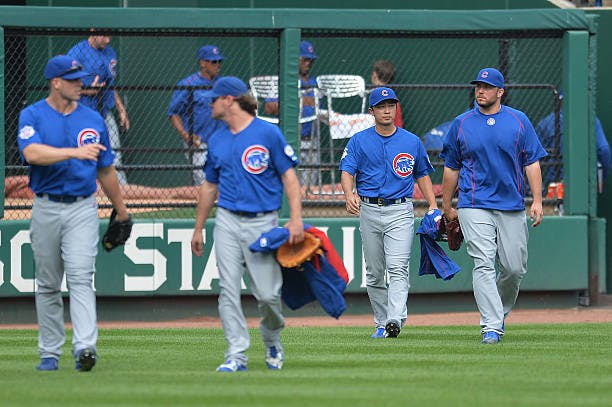
How to Assemble a Lock-Down Bullpen
- By Brandon Ogle
Former Major Leaguer Dennis Eckersley once described the bullpen when he stated, “When I first came up, the bullpen was pretty much where they put the guys who couldn’t start.” While that might of have been how Eckersley thought of the pen, the truth is this description is not always the case. Yes, sometimes guys are tossed in the pen due to trouble pitching deep into games, but other times player’s skillsets are just designed for 1 or 2 innings at a time. In this article, I’ll look at the different pieces needed in a pen.
Quality of Starting Pitching
When examining a team’s bullpen, you need to first look at the starting pitching. If the starting pitching is horrible, chances are it can turn a good bullpen into a poor one. This is because when the starters only throw three or four innings each game, the bullpen starts having to throw more and more innings. As a result, their effectiveness falls due to fatigue and more runs cross the plate. Conversely, if a team has a starting rotation that can consistently pitch deep into games, the bullpen isn’t used as frequently. If this is the case, then the manager also has more flexibility in choosing who to put out on the mound in late-inning scenarios. Though starting pitching isn’t always a determining factor in the performance of a bullpen, it can definitely affect it.
Closer
On any particular baseball team, the closer can be an integral part of the success of the club. With this importance also comes the possibility to be a scapegoat because your job is to pitch one inning. For this reason, some baseball experts think closers are overrated due to the fact that they’re just pitching one inning, it just happens to be the potential final half-inning of the ballgame. As a result, some people encourage the use of closer-by-committee, which implements a few pitchers as possibilities for 9th inning duties.
In terms of the player you’re looking for to be a closer, he or she should be a pitcher with dominant swing-and-miss stuff. While pitchers that pitch to contact can be effective as a closer, it often isn’t recommended among coaches. You also want a player that has thick skin, someone that won’t let one bad outing affect future performances.
Check out this video on CoachTube about utilizing your fastball early and often to rack up the strikeouts as a closer. Top Baseball Courses From The Best Coaches and Instructors In The Game! Enter Ambassador Code: 11586773 for all availalbe discounts
Set-Up Man
With the set-up man, the name practically gives it away. The player holding this position pitches the 8th inning and attempts to hold the lead before handing the ball off to the closer. In a way, you could think of the set-up man as being the closer in-waiting. If the closer were to have a couple slip-ups, future save opportunities could be passed to the set-up man.
For a set-up, I recommend looking for similar qualities as your closer. If you’re lucky enough to have two relievers with closer-type stuff, then the 8th and 9th should be lockdown innings on most occasions. However, for most teams, the set-up man might not have the elite swing-and-miss pitches as the closer, but nonetheless is a reliable arm in the latter innings.
Left-Handed Specialist
Pitchers that are considered left-handed specialists are those that throw left-handed and come in to primarily face left-handed hitters. If needed, they can come in to potentially pitch an entire inning, but that is not generally their primary role. Over the years, statistics have proven the point that left-handed hitters generally have more trouble with left-handed pitchers. Part of this is due to how the curveball breaks. The unique aspect with left-handed specialists is that they generally come in to face just one batter in a late inning to preserve the lead. This position leaves little room for error and requires a pitcher that is a model of consistency. Due to the diminished role, managers need pitchers they can trust to deliver in the few pitches they throw on the mound.
Long-Relief
Remember that quote from Dennis Eckersley in the introduction? Well, it actually comes into play with long-relievers. Pitchers in the long-relief role are usually ones that intend to be a starting pitcher, but either due to a lack of talent or crowded rotation are forced to pitch out of the pen. Their main times on the mound are when the starter has to leave early, like in the 3rd through 5th inning. Whether this early departure is the result of ineffectiveness, injury or ejection, the long reliever comes in to mop up some innings and prevent the other relievers from wasting pitches on a possibly already lost game.
For pitchers in the long-relief role, I recommend using this opportunity as a chance to prove something to your coach. By pitching effectively over a few innings as a long reliever, coaches might begin to reevaluate whether you should be a starter. Additionally, long relievers usually come in when the starter isn’t getting the job done, so a spot in the rotation might be on the verge of opening up.
Middle-Relief
Middle relievers offer a few similarities to long relievers. They’re often going to be entering the game in the middle innings, from the fifth to the seventh. These relievers are also capable of throwing multiple innings, so they might have some starting experience in the past. The primary difference between middle and long relievers is the fact that games are still going to be relatively close when they enter the game. While they could come in as early as the fifth, there is a chance this entrance is just the result of a pitcher throwing too many pitches, rather than a blowout being in the making. Coaches looking for middle relievers should look for guys that have starting stuff. At the same time, the manager should have confidence that this player can pitch with a lead and maintain that differential as well.
Group Unity
A good bullpen can help win games. This bullpen construction becomes much easier when you have the right players personality-wise and the talent in terms of pitchers for each role. This idea of ‘group unity’ defines a bullpen where every player knows their own designated role. You don’t want set-up pitchers that are hoping for the closer to hiccup just so they can steal the 9th inning role. It is ideal to have pitchers in place that feed off the energy of their teammates and are excited each time they get a chance to get on the mound, no matter the situation.
Great Bullpens Top-to-Bottom
Throughout history, there have been a few bullpens that single-handedly help get teams through the regular season and postseason. One in particular is the 2015 Kansas City Royals, who have utilized their pen to help follow up their 2014 American League pennant. Here is what their bullpen is comprised of:
Closer: Greg Holland – The 5-foot-10 closer has been one of the most elite stoppers during his time. The ERA’s over his previous four seasons read 1.80, 2.96, 1.21 and 1.44. At the same time, he’s proven the ability to strike out over a batter per inning.
Set-Up Man: Wade Davis – The set-up man on this Royals squad is actually a former starter, but has been much more effective out of the pen. When given the opportunity, Davis has proven he has the ability to get a save. Were the Royals to trade away Holland, Davis could easily take over.
Left-Handed Specialist: Franklin Morales – The Royals only have one lefty in the pen and that man happens to be Morales. Even though he can pitch to more batters, the depth of the Royals’ pen allows them to mainly pitch Morales to lefties.
Long-Relief: Chris Young and Kris Medlen – The long relievers include two former starters. Young has been in and out of the rotation and Medlen is coming off an injury. Both pitchers have the ability to be starters, but at the time, can’t crack the starting rotation.
Middle-Relief: Luke Hochevar, Ryan Madson and Kelvin Herrera – The unique part about the Royals pen is that all of these middle relievers have the stuff to be elite set-up men. Their strikeout numbers and low ERA’s warrant this recognition. Right now, they all take turns in pitching in tight games, from the 6th inning on.
Piece-by-Piece
The way I look at assembling a bullpen involves getting numerous pitchers in place. Just having a shut-down closer doesn’t mean much if the rest of the pen is weak. This is because the closer will never get in there in a save situation if the other guys are blowing the lead earlier. So, in essence, you must look at every piece and the personnel available before defining roles. Taking it on a piece-by-piece approach will get the pen to shut-down status quicker than going after one top closer.


